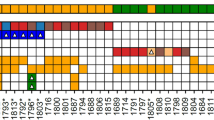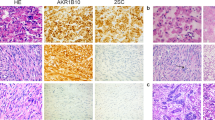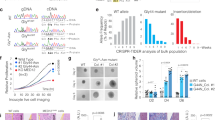Abstract
Defects of metabolic enzymes result in a variety of manifestations not logically explained by the primary metabolic function. Dominant defects of fumarate hydratase (FH) result in predisposition to cutaneous and uterine leiomyomas, and renal cell cancer. FH is a metabolic enzyme of the tricarboxylic acid cycle, and its tumor-suppressor mechanism is not fully understood. We compared the consequences of FH deficiency and respiratory chain (RC) deficiency using global expression pattern of diploid primary fibroblasts. This approach utilized the information that RC defects do not seem to predispose to tumorigenesis, and the aim was to identify FH-specific signaling effects that might have relevance to tumor formation. These results were then compared to global expression patterns of FH-deficient and sporadic uterine leiomyoma data sets. We show here that FH-deficient fibroblasts share a common transcriptional fingerprint with FH-deficient and sporadic leiomyomas, highlighting the downregulation of serum response factor (SRF)-regulated transcripts, particularly the FOS–JUNB pathway. We confirmed the downregulation of this pathway at transcriptional and protein level. SRF has a fundamental function in the differentiation of smooth muscle progenitor cells, and its downregulation both in diploid FH-deficient primary fibroblasts and in leiomyomas suggests an early function in the mechanism of uterine leiomyoma formation in FH deficiency. Concordantly, the phosphorylated form of SRF, known to activate transcription, is undetectable in leiomyomas whereas clearly detected in several nuclei in the differentiated myometrium. A similar transcriptional SRF-pathway fingerprint in FH-deficient and sporadic leiomyomas emphasizes the potential importance of this pathway in primary events leading to leiomyomatosis.
This is a preview of subscription content, access via your institution
Access options
Subscribe to this journal
Receive 50 print issues and online access
$259.00 per year
only $5.18 per issue
Buy this article
- Purchase on Springer Link
- Instant access to full article PDF
Prices may be subject to local taxes which are calculated during checkout





Similar content being viewed by others
References
Alam NA, Rowan AJ, Wortham NC, Pollard PJ, Mitchell M, Tyrer JP et al. (2003). Genetic and functional analyses of FH mutations in multiple cutaneous and uterine leiomyomatosis, hereditary leiomyomatosis and renal cancer, and fumarate hydratase deficiency. Hum Mol Genet 12: 1241–1252.
Arsenian S, Weinhold B, Oelgeschlager M, Ruther U, Nordheim A . (1998). Serum response factor is essential for mesoderm formation during mouse embryogenesis. EMBO J 17: 6289–6299.
Arslan AA, Gold LI, Mittal K, Suen TC, Belitskaya-Levy I, Tang MS et al. (2005). Gene expression studies provide clues to the pathogenesis of uterine leiomyoma: new evidence and a systematic review. Hum Reprod 20: 852–863.
Balza Jr RO, Misra RP . (2006). Role of the serum response factor in regulating contractile apparatus gene expression and sarcomeric integrity in cardiomyocytes. J Biol Chem 281: 6498–6510.
Baysal BE, Ferrell RE, Willett-Brozick JE, Lawrence EC, Myssiorek D, Bosch A et al. (2000). Mutations in SDHD, a mitochondrial complex II gene, in hereditary paraganglioma. Science 287: 848–851.
Bourgeron T, Chretien D, Poggi-Bach J, Doonan S, Rabier D, Letouze P et al. (1994). Mutation of the fumarase gene in two siblings with progressive encephalopathy and fumarase deficiency. J Clin Invest 93: 2514–2518.
Campione E, Terrinoni A, Orlandi A, Codispoti A, Melino G, Bianchi L et al. (2007). Cerebral cavernomas in a family with multiple cutaneous and uterine leiomyomas associated with a new mutation in the fumarate hydratase gene. J Invest Dermatol 127: 2271–2273.
Carlini LE, Getz MJ, Strauch AR, Kelm Jr RJ . (2002). Cryptic MCAT enhancer regulation in fibroblasts and smooth muscle cells. Suppression of TEF-1 mediated activation by the single-stranded DNA-binding proteins, Pur alpha, Pur beta, and MSY1. J Biol Chem 277: 8682–8692.
Carvajal-Carmona LG, Alam NA, Pollard PJ, Jones AM, Barclay E, Wortham N et al. (2006). Adult Leydig-cell tumors of the testis caused by germline fumarate hydratase mutations. J Clin Endocrinol Metab 91: 3071–3075.
Catala F, Wanner R, Barton P, Cohen A, Wright W, Buckingham M . (1995). A skeletal muscle-specific enhancer regulated by factors binding to E and CArG boxes is present in the promoter of the mouse myosin light-chain 1A gene. Mol Cell Biol 15: 4585–4596.
Chai J, Tarnawski AS . (2002). Serum response factor: discovery, biochemistry, biological roles and implications for tissue injury healing. J Physiol Pharmacol 53: 147–157.
Chebotaev D, Yemelyanov A, Budunova I . (2007). The mechanisms of tumor suppressor effect of glucocorticoid receptor in skin. Mol Carcinog 46: 732–740.
Du KL, Chen M, Li J, Lepore JJ, Mericko P, Parmacek MS . (2004). Megakaryoblastic leukemia factor-1 transduces cytoskeletal signals and induces smooth muscle cell differentiation from undifferentiated embryonic stem cells. J Biol Chem 279: 17578–17586.
Eisen MB, Spellman PT, Brown PO, Botstein D . (1998). Cluster analysis and display of genome-wide expression patterns. Proc Natl Acad Sci USA 95: 14863–14868.
Eng C, Kiuru M, Fernandez MJ, Aaltonen LA . (2003). A role for mitochondrial enzymes in inherited neoplasia and beyond. Nat Rev Cancer 3: 193–202.
Gottlieb E, Tomlinson IP . (2005). Mitochondrial tumour suppressors: a genetic and biochemical update. Nat Rev Cancer 5: 857–866.
Heidenreich O, Neininger A, Schratt G, Zinck R, Cahill MA, Engel K et al. (1999). MAPKAP kinase 2 phosphorylates serum response factor in vitro and in vivo. J Biol Chem 274: 14434–14443.
Hoffman PJ, Milliken DB, Gregg LC, Davis RR, Gregg JP . (2004). Molecular characterization of uterine fibroids and its implication for underlying mechanisms of pathogenesis. Fertil Steril 82: 639–649.
Irizarry RA, Bolstad BM, Collin F, Cope LM, Hobbs B, Speed TP . (2003). Summaries of Affymetrix GeneChip probe level data. Nucleic Acids Res 31: e15.
Isaacs JS, Jung YJ, Mole DR, Lee S, Torres-Cabala C, Chung YL et al. (2005). HIF overexpression correlates with biallelic loss of fumarate hydratase in renal cancer: novel role of fumarate in regulation of HIF stability. Cancer Cell 8: 143–153.
Janknecht R, Hipskind RA, Houthaeve T, Nordheim A, Stunnenberg HG . (1992). Identification of multiple SRF N-terminal phosphorylation sites affecting DNA binding properties. EMBO J 11: 1045–1054.
Kelm Jr RJ, Wang SX, Polikandriotis JA, Strauch AR . (2003). Structure/function analysis of mouse Purbeta, a single-stranded DNA-binding repressor of vascular smooth muscle alpha-actin gene transcription. J Biol Chem 278: 38749–38757.
Loeffen J, Smeets R, Voit T, Hoffmann G, Smeitink J . (2005). Fumarase deficiency presenting with periventricular cysts. J Inherit Metab Dis 28: 799–800.
Maradin M, Fumic K, Hansikova H, Tesarova M, Wenchich L, Dorner S et al. (2006). Fumaric aciduria: mild phenotype in a 8-year-old girl with novel mutations. J Inherit Metab Dis 29: 683.
Marshall P, Chartrand N, Worton RG . (2001). The mouse dystrophin enhancer is regulated by MyoD, E-box-binding factors, and by the serum response factor. J Biol Chem 276: 20719–20726.
Misra RP, Bonni A, Miranti CK, Rivera VM, Sheng M, Greenberg ME . (1994). L-type voltage-sensitive calcium channel activation stimulates gene expression by a serum response factor-dependent pathway. J Biol Chem 269: 25483–25493.
Mittelstadt PR, Ashwell JD . (2003). Disruption of glucocorticoid receptor exon 2 yields a ligand-responsive C-terminal fragment that regulates gene expression. Mol Endocrinol 17: 1534–1542.
Parlakian A, Tuil D, Hamard G, Tavernier G, Hentzen D, Concordet JP et al. (2004). Targeted inactivation of serum response factor in the developing heart results in myocardial defects and embryonic lethality. Mol Cell Biol 24: 5281–5289.
Phuc Le P, Friedman JR, Schug J, Brestelli JE, Parker JB, Bochkis IM et al. (2005). Glucocorticoid receptor-dependent gene regulatory networks. PLoS Genet 1: e16.
Pipes GCT, Creemers EE, Olson EN . (2006). The myocardin family of transcriptional coactivators: versatile regulators of cell growth, migration, and myogenesis. Genes Dev 20: 1545–1556.
Pollard P, Wortham N, Barclay E, Alam A, Elia G, Manek S et al. (2005a). Evidence of increased microvessel density and activation of the hypoxia pathway in tumours from the hereditary leiomyomatosis and renal cell cancer syndrome. J Pathol 205: 41–49.
Pollard PJ, Briere JJ, Alam NA, Barwell J, Barclay E, Wortham NC et al. (2005b). Accumulation of Krebs cycle intermediates and over-expression of HIF1alpha in tumours which result from germline FH and SDH mutations. Hum Mol Genet 14: 2231–2239.
Pollard PJ, Spencer-Dene B, Shukla D, Howarth K, Nye E, El-Bahrawy M et al. (2007). Targeted inactivation of fh1 causes proliferative renal cyst development and activation of the hypoxia pathway. Cancer Cell 11: 311–319.
Pollard PJ, Wortham NC, Tomlinson IP . (2003). The TCA cycle and tumorigenesis: the examples of fumarate hydratase and succinate dehydrogenase. Ann Med 35: 632–639.
Raimundo N, Ahtinen J, Fumic K, Baric I, Remes AM, Renkonen R et al. (2008). Differential metabolic consequences of fumarate hydratase and respiratory chain defects. Biochim Biophys Acta 1782: 287–294.
Refae MA, Wong N, Patenaude F, Begin LR, Foulkes WD . (2007). Hereditary leiomyomatosis and renal cell cancer: an unusual and aggressive form of hereditary renal carcinoma. Nat Clin Pract Oncol 4: 256–261.
Remes AM, Filppula SA, Rantala H, Leisti J, Ruokonen A, Sharma S et al. (2004). A novel mutation of the fumarase gene in a family with autosomal recessive fumarase deficiency. J Mol Med 82: 550–554.
Rivera VM, Miranti CK, Misra RP, Ginty DD, Chen RH, Blenis J et al. (1993). A growth factor-induced kinase phosphorylates the serum response factor at a site that regulates its DNA-binding activity. Mol Cell Biol 13: 6260–6273.
Rustin P, Bourgeron T, Parfait B, Chretien D, Munnich A, Rotig A . (1997). Inborn errors of the Krebs cycle: a group of unusual mitochondrial diseases in human. Biochim Biophys Acta 1361: 185–197.
Schapira AH . (2006). Mitochondrial disease. Lancet 368: 70–82.
Shozu M, Murakami K, Segawa T, Kasai T, Ishikawa H, Shinohara K et al. (2004). Decreased expression of early growth response-1 and its role in uterine leiomyoma growth. Cancer Res 64: 4677–4684.
Smeitink JA, Zeviani M, Turnbull DM, Jacobs HT . (2006). Mitochondrial medicine: a metabolic perspective on the pathology of oxidative phosphorylation disorders. Cell Metab 3: 9–13.
Tomlinson IP, Alam NA, Rowan AJ, Barclay E, Jaeger EE, Kelsell D et al. (2002). Germline mutations in FH predispose to dominantly inherited uterine fibroids, skin leiomyomata and papillary renal cell cancer. Nat Genet 30: 406–410.
Trifunovic A, Wredenberg A, Falkenberg M, Spelbrink JN, Rovio AT, Bruder CE et al. (2004). Premature ageing in mice expressing defective mitochondrial DNA polymerase. Nature 429: 417–423.
Tyynismaa H, Mjosund KP, Wanrooij S, Lappalainen I, Ylikallio E, Jalanko A et al. (2005). Mutant mitochondrial helicase Twinkle causes multiple mtDNA deletions and a late-onset mitochondrial disease in mice. Proc Natl Acad Sci USA 102: 17687–17692.
Vanharanta S, Pollard PJ, Lehtonen HJ, Laiho P, Sjoberg J, Leminen A et al. (2006). Distinct expression profile in fumarate-hydratase-deficient uterine fibroids. Hum Mol Genet 15: 97–103.
Walker CL, Stewart EA . (2005). Uterine fibroids: the elephant in the room. Science 308: 1589–1592.
Wang GL, Semenza GL . (1995). Purification and characterization of hypoxia-inducible factor 1. J Biol Chem 270: 1230–1237.
Wei J, Chiriboga L, Mizuguchi M, Yee H, Mittal K . (2005). Expression profile of tuberin and some potential tumorigenic factors in 60 patients with uterine leiomyomata. Mod Pathol 18: 179–188.
Weinhold B, Schratt G, Arsenian S, Berger J, Kamino K, Schwarz H et al. (2000). Srf(−/−) ES cells display non-cell-autonomous impairment in mesodermal differentiation. EMBO J 19: 5835–5844.
Ylisaukko-Oja SK, Cybulski C, Lehtonen R, Kiuru M, Matyjasik J, Szymanska A et al. (2006). Germline fumarate hydratase mutations in patients with ovarian mucinous cystadenoma. Eur J Hum Genet 14: 880–883.
Zhang SX, Garcia-Gras E, Wycuff DR, Marriot SJ, Kadeer N, Yu W et al. (2005). Identification of direct serum-response factor gene targets during Me2SO-induced P19 cardiac cell differentiation. J Biol Chem 280: 19115–19126.
Acknowledgements
We thank Heli Lehtonen for providing the paraffin sections and Markus Innilä for skillful immunohistochemistry. The following funding sources are gratefully acknowledged: Helsinki Biomedical Graduate School (NR), Sigrid Juselius Foundation (AS and LA), Centre of Excellence program of Academy of Finland and University of Helsinki (AS and LA) and EMBO Young Investigator Program (AS).
Financial support: Academy of Finland, Helsinki University, Sigrid Juselius Foundation (for AS), Helsinki Biomedical Graduate School (for NR).
Author information
Authors and Affiliations
Corresponding author
Additional information
The authors declare no conflict of interest.
Disclosure/conflict of interest
Supplementary Information accompanies the paper on the Oncogene website (http://www.nature.com/onc)
Supplementary information
Rights and permissions
About this article
Cite this article
Raimundo, N., Vanharanta, S., Aaltonen, L. et al. Downregulation of SRF–FOS–JUNB pathway in fumarate hydratase deficiency and in uterine leiomyomas. Oncogene 28, 1261–1273 (2009). https://doi.org/10.1038/onc.2008.472
Received:
Revised:
Accepted:
Published:
Issue Date:
DOI: https://doi.org/10.1038/onc.2008.472
Keywords
This article is cited by
-
Macrophage fumarate hydratase restrains mtRNA-mediated interferon production
Nature (2023)
-
Genetic variant of SRF-rearranged myofibroma with a misleading nuclear expression of STAT6 and STAT6 involvement as 3′ fusion partner
Virchows Archiv (2021)
-
Mitochondrial function — gatekeeper of intestinal epithelial cell homeostasis
Nature Reviews Gastroenterology & Hepatology (2018)
-
Inborn and acquired metabolic defects in cancer
Journal of Molecular Medicine (2011)



